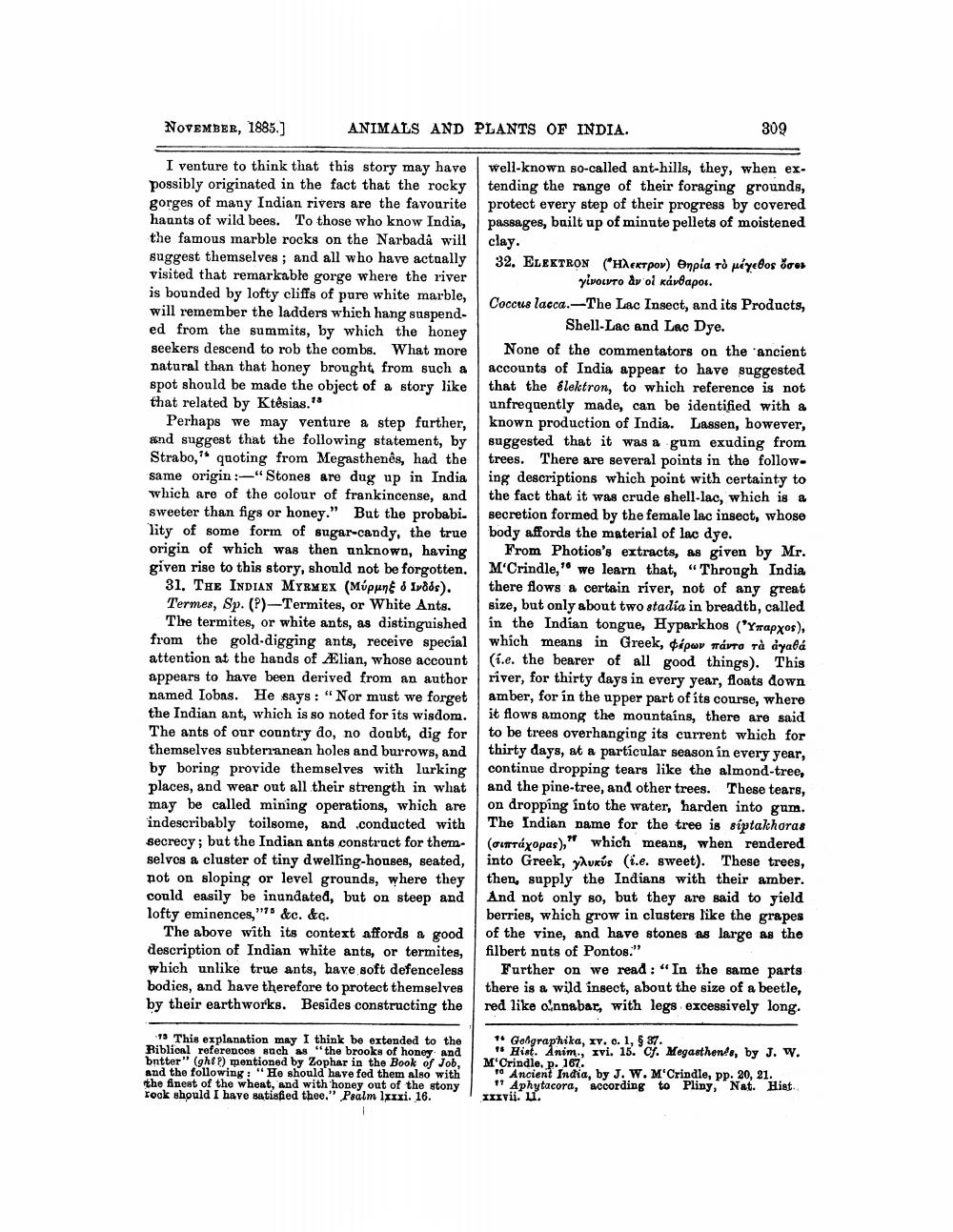________________
NOVEMBER, 1885.)
ANIMALS AND PLANTS OF INDIA.
309
I venture to think that this story may have well-known so-called ant-hills, they, when ex. possibly originated in the fact that the rocky tending the range of their foraging grounds, gorges of many Indian rivers are the favourite protect every step of their progress by covered haunts of wild bees. To those who know India, passages, built up of minute pellets of moistened the famous marble rocks on the Narbadå will clay. suggest themselves; and all who have actually 32. ELEKTRON (Hextpov) Onpia tò mixedos oros visited that remarkable gorge where the river
γίνoιντο αν οι κάνθαροι. is bounded by lofty cliffs of pure white marble, will remember the ladders which hang suspend
Coccus lacca.-The Lac Insect, and its Products, ed from the summits, by which the honey
Shell-Lac and Lac Dye. seekers descend to rob the combs. What more None of the commentators on the ancient natural than that honey brought from such a accounts of India appear to have suggested spot should be made the object of a story like that the Elektron, to which reference is not that related by Ktesias.
unfrequently made, can be identified with & Perhaps we may venture a step further, known production of India. Lassen, however, and suggest that the following statement, by suggested that it was a gum exuding from Strabo, quoting from Megasthenés, had the trees. There are several points in the followsame origin : "Stones are dug up in India ing descriptions which point with certainty to which are of the colour of frankincense, and the fact that it was crude shell-lac, which is a sweeter than figs or honey." But the probabi. secretion formed by the female lac insect, whose lity of some form of sugar-candy, the true body affords the material of lac dye. origin of which was then unknown, having | From Photios's extracts, as given by Mr. given rise to this story, should not be forgotten. M'Crindle, we learn that, “Through India 31. THE INDIAN MYRMEX (Múpung Iv&ds). there flows a certain river, not of any great Termes, Sp. (P)-Termites, or White Ants. size, but only about two stadia in breadth, called
The termites, or white ants, as distinguished in the Indian tongue, Hyparkhos ('Yxapxos), from the gold digging ants, receive special | which means in Greek, φέρων πάντα τα αγαθά attention at the hands of Ælian, whose account (i.e. the bearer of all good things). This appears to have been derived from an author river, for thirty days in every year, floats down named Iobas. He says: "Nor must we forget amber, for in the upper part of its course, where the Indian ant, which is so noted for its wisdom. it flows among the mountains, there are said The ants of our country do, no doubt, dig for to be trees overhanging its current which for themselves subterranean holes and burrows, and thirty days, at a particular season in every year, by boring provide themselves with lurking continue dropping tears like the almond-tree, places, and wear out all their strength in what and the pine-tree, and other trees. These tears, may be called mining operations, which are on dropping into the water, harden into gum. indescribably toilsome, and conducted with The Indian name for the tree is siptakhoras secrecy; but the Indian ants construct for them- (cittáxOpas)," which means, when rendered selves a cluster of tiny dwelling-honses, seated, | into Greek, yukús (i.e. sweet). These trees, pot on sloping or level grounds, where they then, supply the Indians with their amber. conld easily be inundated, but on steep and And not only so, but they are said to yield lofty eminences, &c. &c.
berries, which grow in clusters like the grapes The above with its context affords a good of the vine, and have stones as large as the description of Indian white ants, or termites, filbert nuts of Pontos." which unlike true ants, have soft defenceless Further on we read : "In the same parts bodics, and have therefore to protect themselves there is a wild insect, about the size of a beetle, by their earthworks. Besides constructing the red like oinnabar, with legs excessively long.
13 This explanation may I think be extended to the Biblical references such as "the brooks of honey and bntter" (ghi) mentioned by Zophar in the Book of Job, and the following: "Ho should have fed them also with the finest of the wheat, and with honey out of the stony rock should I have satisfied thee." Psalm lxxxi. 16.
1 Hist. Anim. xvi. 15. cf. Megasthenis, by J. W. M'Crindle, p. 167.
10 Ancient India, by J. W. M'Crindle, pp. 20, 21.
"Aphytacora, according to Pliny, Nat. Hist. Ixxvii. u.




